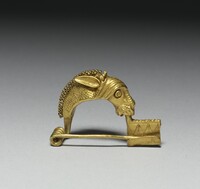Hunnic fibula and horse trappings
Type:
Fibulae,
Horse trappings
Date:
Fourth to early fifth century
Location or Findspot (Modern-Day Country):
Russia
Description:
This fibula, a type of brooch used for fastening garments, incorporates the head and neck of a horse into its design. The choice of imagery reflects the importance of horses to the Huns, a nomadic group from the Eurasian steppe who crossed the Volga River (modern-day Russia) shortly after 370 CE. The fibula and horse fittings reproduced here are products of the fourth to early fifth century and were discovered in Russia. The larger piece, called a chamfron, was worn above the horse's eyes and served an ornamental rather than functional purpose. The gold tube was originally the handle for a Hunnic whip (nagaika), which riders used instead of spurs.
Relevant Textbook Chapter(s):
2
Repository and Online Resources:
• Read more about the fibula on the website of the Walters Art Museum.
• Read more about the horse trappings on the website of the Walters Art Museum.


